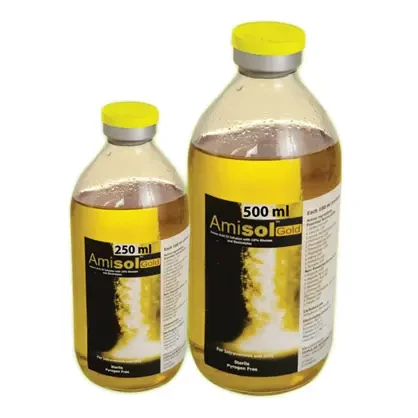Amisol Gold IV Infusion
Pack Image
7%+10%
500 ml bottle:
৳ 490.00
Indications
This is indicated as a source of amino acids, glucose and electrolytes in adult and pediatric patients needing IV nutrition. This is particularly suitable for patients with basal amino acid requirements.
* রেজিস্টার্ড চিকিৎসকের পরামর্শ মোতাবেক ঔষধ সেবন করুন
Composition
Each 100 ml contains-
Essential Amino Acids:
Essential Amino Acids:
- L-Isoleucine 0.390 gm
- L-Leucine 0.530 gm
- L-Lysine Hydrochloride 0.390 gm
- L-Methionine 0.190 gm
- L-Phenylalanine 0.550 gm
- L-Threonine 0.300 gm
- L-Tryptophan 0.100 gm
- L-Valine 0.430 gm
- L-Histidine 0.240 gm
- L-Tyrosine 0.050 gm
- L-Arginine 0.330 gm
- L-Aspartic Acid 0.410 gm
- L-Glutamic Acid 0.900 gm
- L-Alanine 0.300 gm
- L-Cystine 0.140 gm
- Glycine (Aminoacetic Acid) 0.210 gm
- L-Proline 0.810 gm
- L-Serine 0.750 gm
- Anhydrous Glucose 10.00 gm
- Sodium (Na+) 50.0 mmol/L
- Potassium (K+) 20.0 mmol/L
- Calcium (Ca++) 2.5 mmol/L
- Magnesium (Mg++) 1.5 mmol/L
- Chloride (Cl-) 32.0 mmol/L
Description
This is a sterile aqueous solution of 7% amino acids IV infusion and 10% glucose with electrolytes, which are necessary as nitrogen sources for parenteral nutrition. Nitrogen is provided in the form of essential and non essential amino acids. This contains all 18 essential and non-essential amino acids needed for protein synthesis. The amino acid composition is such that positive nitrogen balance can be achieved in the postoperative period and during extended periods of intravenous nutrition.
Pharmacology
A crystalline amino acid solution provides crystalline amino acids to promote protein synthesis and wound healing, and to reduce the rate of endogenous protein catabolism. Amino Acids given by central venous infusion in combination with concentrated dextrose, electrolytes, vitamins, trace metals, and ancillary fat supplements, constitutes total parenteral nutrition (TPN). Amino Acids can also be administered by peripheral vein with dextrose and maintenance electrolytes.
Dosage & Administration
Adults: The nitrogen requirement for maintenance of body protein mass depends on the patient's condition (nutritional state and degree of metabolic stress). The requirements are 0.10-0.15g nitrogen/kg/day (no or minor metabolic stress and normal nutritional state), 0.15-0.20g nitrogen/kg/day (moderate metabolic stress with or without malnutrition) and up to 0.20-0.25g nitrogen/kg/day (severe catabolism as in burns, sepsis and trauma). The dosage range is 0.10-0.25 g nitrogen/kg/day corresponds to 11-27 ml/kg/day. In obese patients, the dose should be based on the estimated ideal weight. Depending upon the patient’s requirements, 1000-2000 ml may be infused intravenously per 24 hours. This should be infused slowly; at a rate not exceeding 500 ml in 3 hours corresponding to approximately at rates 1.4-2.8 ml (30-60 drops) per minute.
Infants and children: In infants & children, a maximal rate of infusion of 30 ml/kg body weight/day is recommended, with a step-wise increase in the rate of administration during the first week of treatment.
Infants and children: In infants & children, a maximal rate of infusion of 30 ml/kg body weight/day is recommended, with a step-wise increase in the rate of administration during the first week of treatment.
* রেজিস্টার্ড চিকিৎসকের পরামর্শ মোতাবেক ঔষধ সেবন করুন
Interaction
At the recommended dosage this solution has no pharmacological effect and is expected not to interact with other medicaments.
Contraindications
This preparation is contraindicated in patients with inborn errors of amino acids metabolism, severe liver damage & severe uremia when dialysis facilities are not available. Due to the content of the glucose, this preparation is contraindicated in patients with hyperosmolar nonketotic diabetic coma. This preparation is also contraindicated in patients with known hypersensitivity to any of its ingredients.
Side Effects
Amisol Gold is usually well tolerated. Nausea occurs rarely. Vomiting, flushing and sweating have been observed during infusion of the solution at rates exceeding the recommended maximal rate. Transient increases in liver test during intravenous nutrition have been reported. The reasons are at present unclear. The underlying disease and the components and their amount in the intravenous feeding regimens have been suggested. Hypersensitivity reactions have been reported. As with all hypertonic infusion solution, thrombophlebitis may occur when peripheral veins are used. The incidence may be reduced by the simultaneous infusion of 10% fat emulsion.
Pregnancy & Lactation
Successful and safe administration of amino acid solution during pregnancy in human has been reported. Animal reproduction studies have not been carried out with 7% amino acid IV infusion with 10% glucose & electrolytes.
Precautions & Warnings
Hyperphenylalaninemia has been noted in severely ill, premature infants. In these patients, monitoring of the phenylalanine level is recommended and the infusion rate to be adjusted as needed. Amisol Gold should be used with caution in patients with diabetes mellitus, severe heart failure or with renal function in combination with fluid restriction or oliguria/anuria of other origin. In patient with hyperglycemia, administration of exogenous insulin might be necessary. Do not use if the solution is turbid or contains particles. Discard any unused portion.
Therapeutic Class
Parenteral nutritional preparations
Storage Conditions
Protect from light and store between 15°C to 25°C temperature. Avoid freezing. Keep away from the reach of children.

